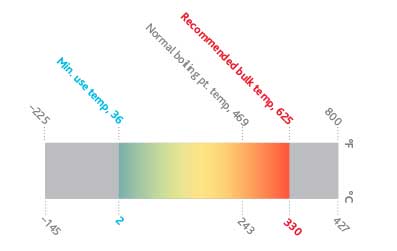Top Factors To Consider for Selecting the Right Heat Transfer Fluid for Your Requirements
Why Warm Transfer Liquid Is Very Important for Optimizing Power Transfer in Equipment
The duty of heat transfer fluids in enhancing energy transfer is pivotal for attaining reliable thermal management throughout various industrial sectors. These liquids promote smooth heat exchange, guaranteeing processes run within ideal temperature ranges and minimizing the danger of overheating.

Duty in Thermal Management
Warmth transfer liquids play a critical duty in thermal administration by effectively controling temperatures in various commercial procedures and systems. These specialized fluids help with the transfer of heat in between various elements, guaranteeing optimal operating problems and protecting against getting too hot. By preserving accurate temperature level control, warmth transfer liquids allow industries such as chemical manufacturing, oil and gas, and power generation to operate securely and effectively.
The selection of a proper warm transfer fluid relies on a number of factors, consisting of thermal security, heat ability, and viscosity. High thermal stability ensures that the liquid can stand up to extreme temperature levels without weakening, while a high warm capability allows it to soak up and launch substantial amounts of heat - heat transfer fluid. Reduced thickness decreases the power required for pumping, contributing to general system efficiency
Furthermore, warm transfer liquids are important in applications like refrigeration, where they help absorb and dissipate warm during the cooling cycle. In solar thermal energy systems, these liquids capture and transport solar warm to generate electricity or supply hot water. Their versatility to varied operating conditions and capacity to maintain constant thermal efficiency underscore their significance in commercial thermal management, assisting in operational continuity and improving safety and security steps.

Enhancing System Effectiveness
To optimize the advantages of thermal management, enhancing system efficiency with the calculated usage of warm transfer liquids is extremely important. By maintaining optimal temperature levels, heat transfer fluids help ensure that systems operate within their developed specifications, consequently protecting against getting too hot and lowering the danger of element failure.
Types of Heat Transfer Liquids
The variety of warmth transfer liquids emphasizes their crucial function in a series of industrial applications, each tailored to meet specific thermal management requirements. These fluids help with effective energy transfer and are selected based on key residential or commercial properties such as thermal stability, viscosity, and heat ability. The key kinds include water, glycol services, oils, and synthetics, each offering distinct advantages.
Water is the most typical warm transfer tool because of its high certain warmth ability and affordable. Its use is restricted by its freezing go to website and steaming factors. Glycol mixtures, often used in a/c systems, supply a reduced freezing factor, adding flexibility in various climates. Mineral oils are favored for their thermal stability and non-corrosive nature, making them ideal for high-temperature applications.

These fluids guarantee remarkable efficiency in systems where typical fluids may fail. The choice of a warmth transfer fluid is vital, as it affects system efficiency, safety, and long life.
Environmental and Economic Conveniences
Utilizing the best heat transfer fluids provides significant ecological and financial benefits for commercial procedures. Environmentally friendly heat transfer fluids, frequently eco-friendly and non-toxic, decrease the danger of dirt and water contamination in the event of leakages or spills, therefore shielding ecosystems and complying with rigorous environmental laws.
Financially, the right warm transfer liquid can considerably decrease operational prices. Efficient warm transfer lowers energy expense, causing lower energy costs and enhanced productivity. Liquids with extended lifecycle performance decrease the frequency of replacements and maintenance, reducing downtime and associated costs. Purchasing top quality liquids can additionally alleviate the risk of equipment deterioration and failure, staying clear of expensive fixings and expanding the life expectancy of essential framework. In competitive markets, these cost savings and efficiencies supply an unique advantage, permitting companies to designate sources more efficiently and buy additional innovation. In general, the critical use ideal warm transfer fluids sustains sustainable financial development and ecological stewardship.
Picking the Right Fluid
How does one browse the intricate procedure of choosing the ideal heat transfer fluid for industrial applications? Selecting the suitable fluid is essential, as it straight affects system effectiveness, safety and security, and operational expenses. Trick considerations consist of thermal security, compatibility with system products, and operating her response temperature level range. Thermal security ensures the liquid can stand up to high temperature levels without degrading, while compatibility stops deterioration or other damaging responses with system explanation elements. The operating temperature level range have to straighten with the system's needs to preserve efficiency and long life - heat transfer fluid.
In addition, the fluid's heat capability and thickness are vital. A high warmth capacity allows the fluid to soak up and move more energy, enhancing performance.
Verdict
The critical selection and application of warmth transfer fluids are basic to maximizing energy transfer throughout various systems. By making certain high thermal stability and capacity, these fluids offer specific temperature control and improve overall system effectiveness.